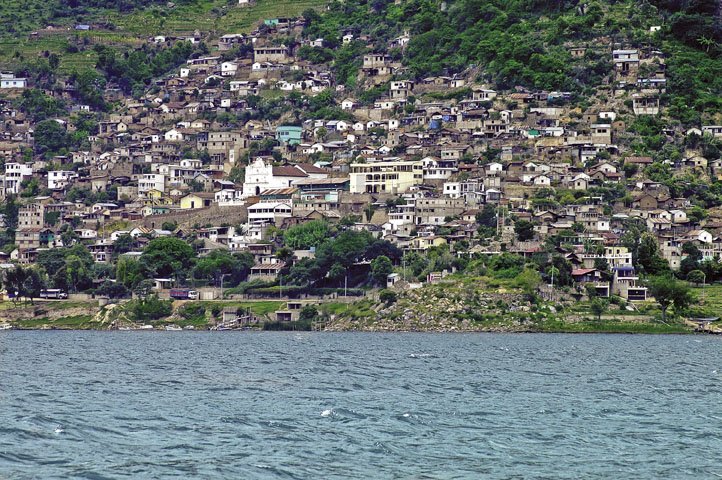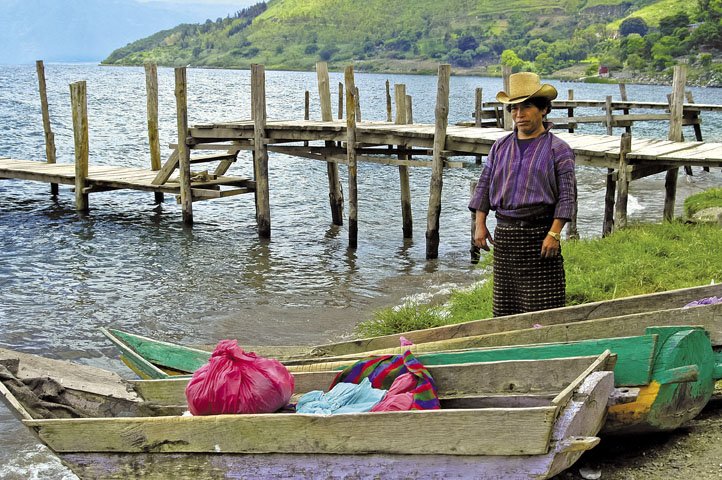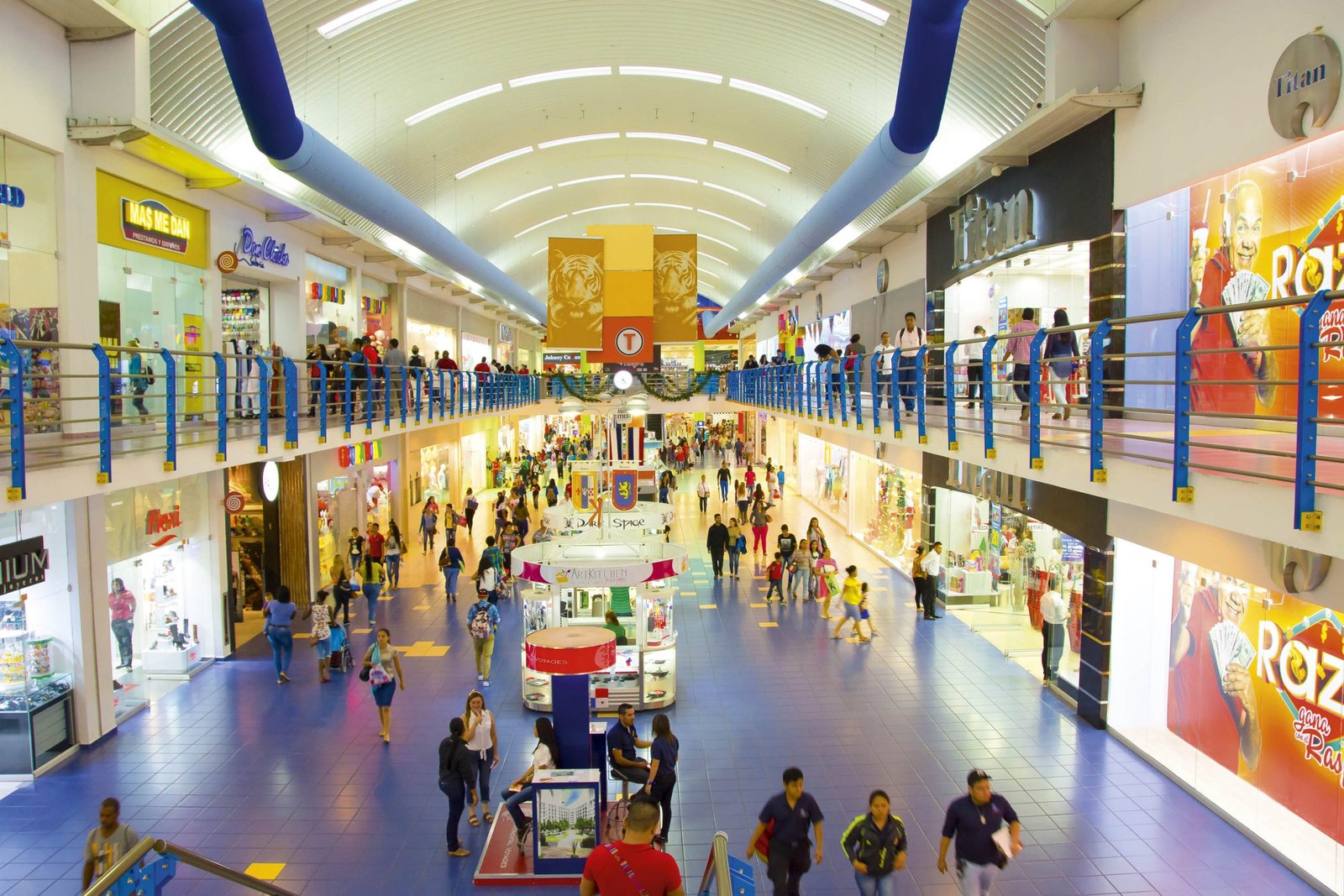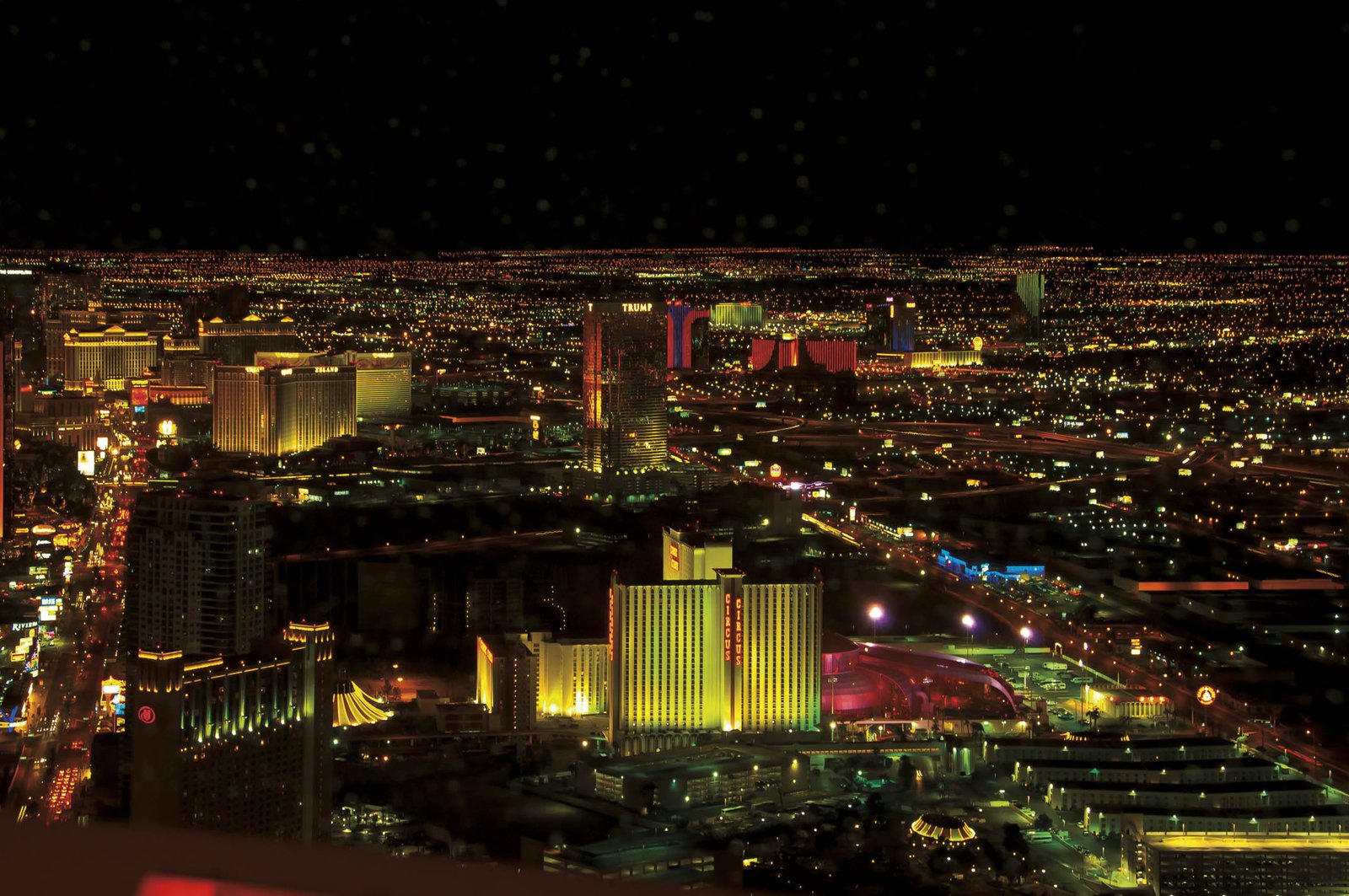

A Visit to Lake Atitlán
Por Sol Lauria
Fotos: Carlos Gómez
Groups of houses, rough roads, and constant sunshine characterize this paradise in southwestern Guatemala, ninety miles from the capital. Cakchah walks with his arms hanging at his sides and his head bent forward, perhaps to avoid the glare of the sun or help propel himself up a slope.
“Let’s go, let’s go! Let’s go see Maximón,” he invites us, telling us that Maximón is the god here.
“Here” is Santiago Atitlán, the jumping-off point for a tour-sail-hike-outing around Lake Atitlán, which occupies a crater created by an eruption 84,000 years ago, the towns on its shores, and the volcanoes Atitlán, Tolimán, and San Pedro.
Visitors arrive via Panajachel, the gateway city to the crystalline lake, which is the deepest lake in Central America. The mirrored surface is so blue it is reminiscent of the ocean, and its shores are home to the Cakchiquel, Tzutujil, and Quiché communities. Touring these towns gives us an idea of what the continent must have been like before the Spaniards arrived. The three most-visited towns are Santiago, Santa Catarina Palopó, and San Antonio Palopó, but there are others as well. The biblically tinged names evoke the syncretism that is always present here: San Pedro (St. Peter) La Laguna, San Juan (St. John) La Laguna, and San Lucas (St. Luke) Tolimán, for example.
Names in this corner of the world are curious. In Santiago, the first person we see introduces himself as Cakchah and immediately invites us to see Maximón. Cakchah, as this white-haired guide with a weather-beaten face will later explain, means “white pine” in Cakchiquel, one of the most important Mayan languages in Guatemala. Maximón is definitely an important tourist attraction in these parts: the deity is both a creation and consequence of the combination of pre-Hispanic religious practices and Christian rituals. We still have some distance to cover, however, before we come face to face with Maximón.

The Gateway
Before Maximón and Santiago, there is Panajachel, which is easy to reach: from the national capital, take Bulevar Liberación and then Calzada Roosevelt, skirt Antigua (departure point for daily bus tours and tour packages, starting at 10 Quetzals), and head for Chimaltenango; continue to the sign welcoming visitors to Sololá.
Panajachel, capital of the department of Sololá, has always been associated with a hippie lifestyle. Travelers from around the world come to buy handicrafts and browse the markets and boutiques crammed with local art, or learn about the secrets of pre-Conquest America and the dialogue —sometimes in screams— between conquerors and the conquered. As noted earlier, this is also the springboard for visiting other towns. Boats to Santiago, San Pedro la Laguna, and all the other towns leave from the pier.
Of course, you don’t need to venture across Atitlán to have a good time in Panajachel —just step outside your hotel. In the streets, a range of activity options overwhelm visitors; you can rent a motorbike, car, or bicycle and explore the scenery; hire a guide to visit lesser-known sites; or taste amazing tacos for less than 20 Quetzals. Some resorts even offer excursions and special tours to introduce guests to hidden national symbols. There is also diving; the lake’s sapphire depths and extraordinary clarity make it a popular destination. If you lack equipment or if you just want to take lessons, local dive shops can take care of everything.
There is a good reason Panajachel is one of the four most important and attractive tourist areas in the country: the lake and the volcanoes silhouetted against the sky make for an incomparable view. One of the best ways to see it is to take a boat to Santa Catarina, San Antonio Palopó, or, of course, Santiago Atitlán. It is like stepping back into the past. You encounter ancient tongues, farming, and fishing, all perfumed by the scent of nature.


The Road to Maximón
As soon as you set foot in Santiago, you will be offered guided tours by people who, like Cakchah, are members of the area’s various indigenous groups. These indigenous communities are descendents of the ancient Mayans. Santiago, in the department of Sololá, sits on an inlet that looks like an arm the lake body apparently dropped, pointed toward the Pacific Ocean. It is the town farthest from Panajachel and it competes with San Pedro La Laguna for the best view of the San Pedro volcano.
Before taking visitors to the volcano, the church, or the lookout point, Cakchah offers to take tourists to see Maximón, who seems to be the most powerful god of all here.
Cakchah leads us onward. Along the path, we see a succession of houses outlined against the sky. Cakchah leads us onward and tells us that, like him, the majority of the area’s inhabitants have Cakchiquel names. His means “white pine,” which abounds in this area, although it is not as common as garlic, anise, ceiba, Montezuma cypress, sapodilla, jocote (purple mombin), apples, oranges, or other fruit trees. “Exotic vegetation,” he says. One of Guatemala’s best coffees is also grown and produced here.
He leads us onward toward the forests and mountains, pointing out birds like woodpeckers, quetzals, mockingbirds, solitaires, and jays, all against the backdrop of the lake. Geography books note that this body of water is “located in a volcanic crater called Los Chocoyos.” In real life, it has been called the “Lake of Seven Colors,” and is blessed with uniquely spectacular sunrises and sunsets.


We step off the boat at our first stop and start walking, in search of a god created by superstition, indigenous beliefs, and the influence of the Catholic Church, which was spread through this area by Dominicans and Franciscans during the time of the Conquest. There are other sights worth seeing along the way, mostly people, like female weavers and their children, dressed in home-sewn striped or checked garments in shades of blue. Other women carry fabric-wrapped bundles on their heads. Men in bermudas made of a linen-like material sport sashes and straw hats.
There is also the church, a pilgrimage site for the region’s indigenous peoples. It is built like a Spanish church, but with saints and Christ figures dressed like the local people we just passed. Women wearing the traditional blue blouses of their people are here praying. The church has preserved the convent, the cross in the atrium, and a chapel to the local martyr, Father Francisco Stanley (better known as Father Aplas, a victim of war in Guatemala). The chapel contains his personal items and tells his life story. A Mayan shaman prays at the altar, illustrating the communion between traditional beliefs and practices and Catholicism.


The Last Stop
Cakchah hurries us along. We visit the market and the fair, experiencing the colors, songs in Tz’utujil, and persistent vendors. Cakchah swears that we have already seen what we need to see. There is something to what he says, but he is either being modest or just accustomed to the surroundings: it is easy to see why the folk saying has it that the universe converges here, and “everyone goes to Santiago Atitlán.”
Now we are ready to see why Maximón is the local treasure. He is a deity, tourist attraction, and merchandise: visitors must pay to see Maximón and pay again to take a photo. But this is why we came, so onward.
Maximón smokes —he is shown with a cigar in his mouth— and he is only fifty-one inches tall. Draped in cloth, he wears traditional garments, a tie, handkerchiefs, a hat, and a mask. Some people claim there is a stone idol inside, while others say the figure holds gold.
The icon is surrounded by offerings (candles, liquor, tobacco, beer, and money) left by locals and visitors requesting good fortune, fertility, and happiness. Maximón is unique: a multi-faceted personality, half saint and half god, considered by some to be a manifestation of the historic weakness of the Catholic and Protestant churches, and a reflection of economic, social, and political crises in Central America by others. For locals, Maximón is an intrinsic part of the Catholic religion imported by the Spanish and the Mayan beliefs inherited from their ancestors. Maximón is the first thing visitors hear about; the first and possibly the last word tourists hear during a visit to Lake Atitlán.



